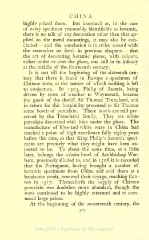Page 454 - Oriental Series Japan and China, Brinkly
P. 454
CHINA
highly prized there. But inasmuch as, in the case
of every specimen reasonably identifiable as keramic,
there is no talk of any decoration other than that ap-
plied to the metal mountings, it may also be con-
cluded and the conclusion is in strict accord with
the researches set forth in previous chapters that
the art of decorating keramic pieces, with colours,
either under or over the glaze, was still in its infancy
at the middle of the fourteenth century.
It is not till the beginning of the sixteenth cen-
tury that there is found in Europe a specimen of
Chinese ware, as the nature of which nothing is left
to conjecture. In 1505, Philip of Austria, being
driven by stress of weather to Weymouth, became
the guest of the sheriff, Sir Thomas Trenchard, and
in return for this hospitality presented to Sir Thomas
some bowls of porcelain. These bowls are still pre-
served by the Trenchard family. They are white
porcelain decorated with blue under the glaze. The
manufacture of blue-and-white ware in China had
reached a point of high excellence fully eighty years
before this date, so that King Philip's keramic speci-
mens are precisely what they might have been ex-
pected to be. To about the same time, or a little
later, belongs the celadon bowl of Archbishop War-
ham, previously alluded to, and in 1508 it is recorded
that the Portuguese, having brought a number of
keramic specimens from China and sold them at a
handsome profit, renewed their voyage, reaching Can-
ton in 1517. Thenceforth the supply of Chinese
porcelain was doubtless more abundant, though the
ware continued to be highly esteemed and to com-
mand large prices.
At the beginning of the seventeenth century, the

